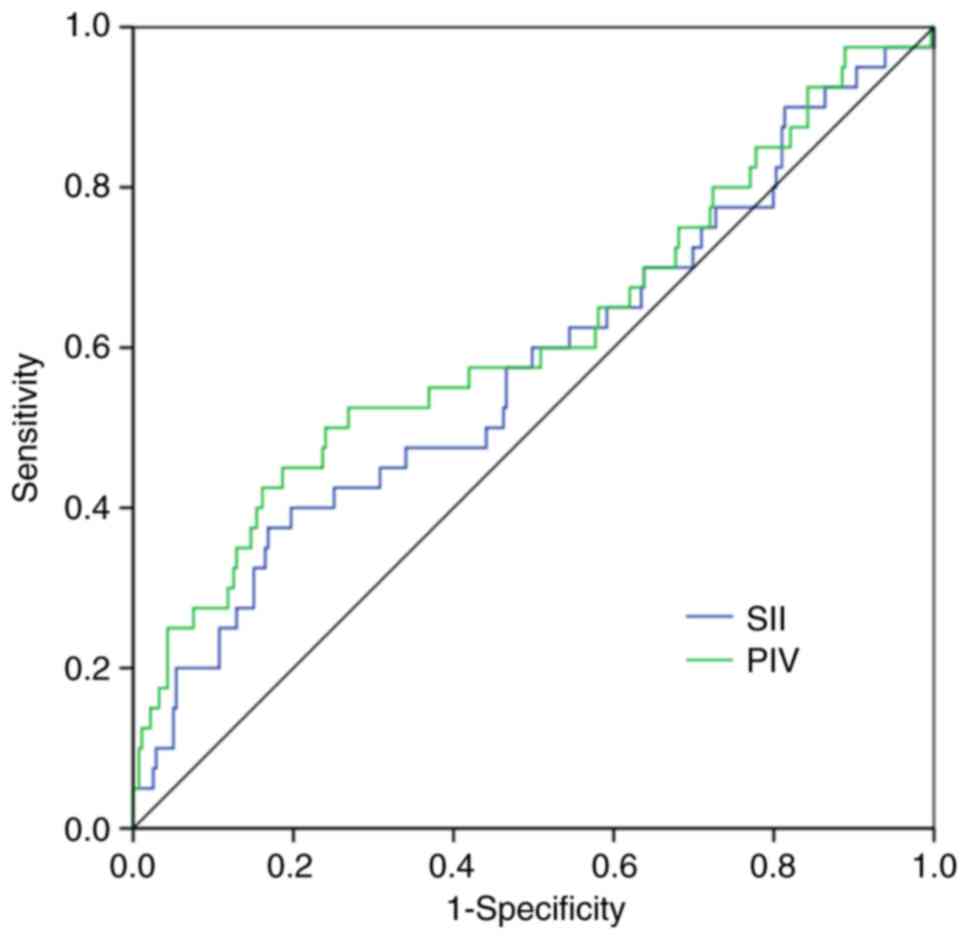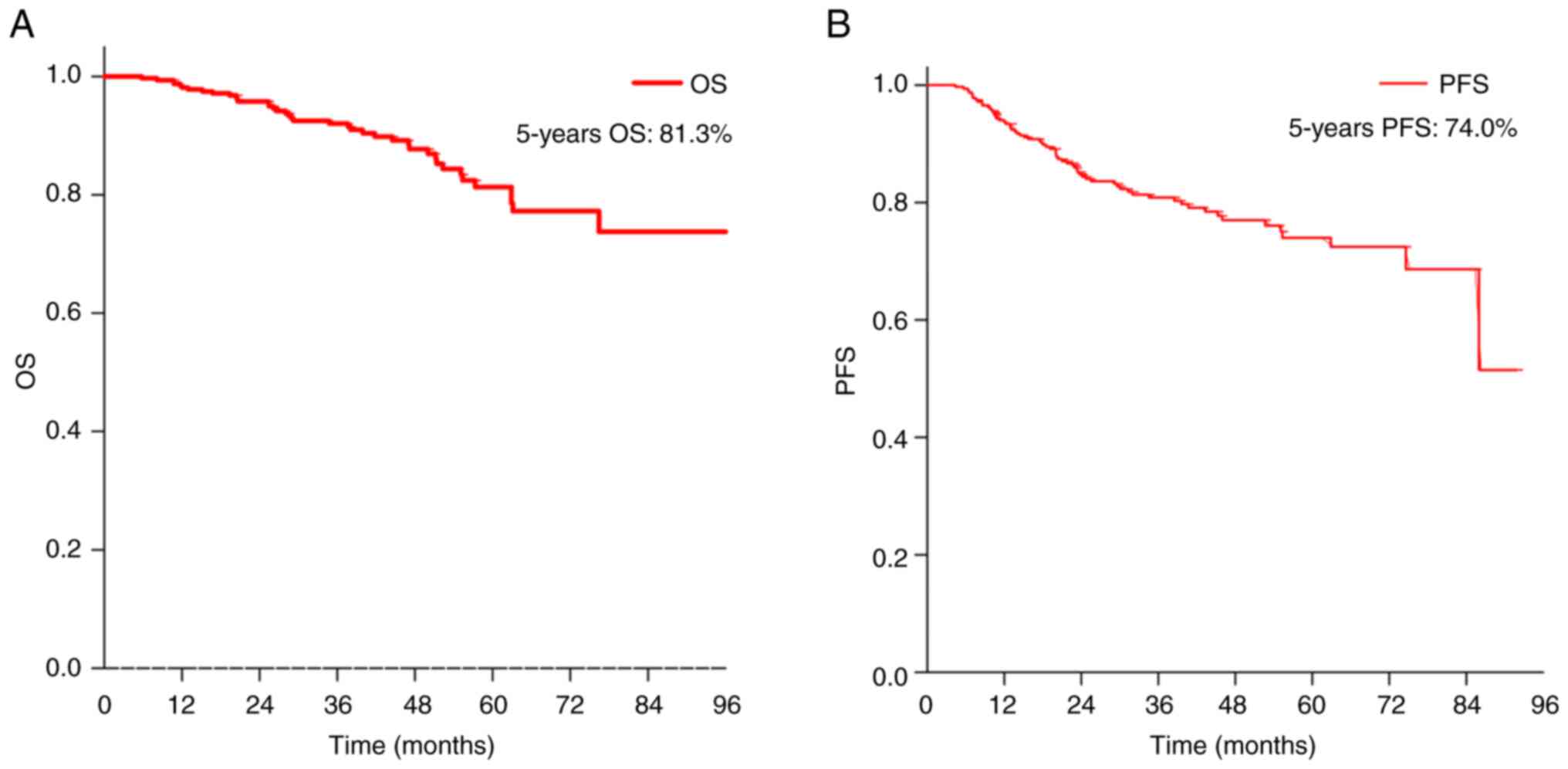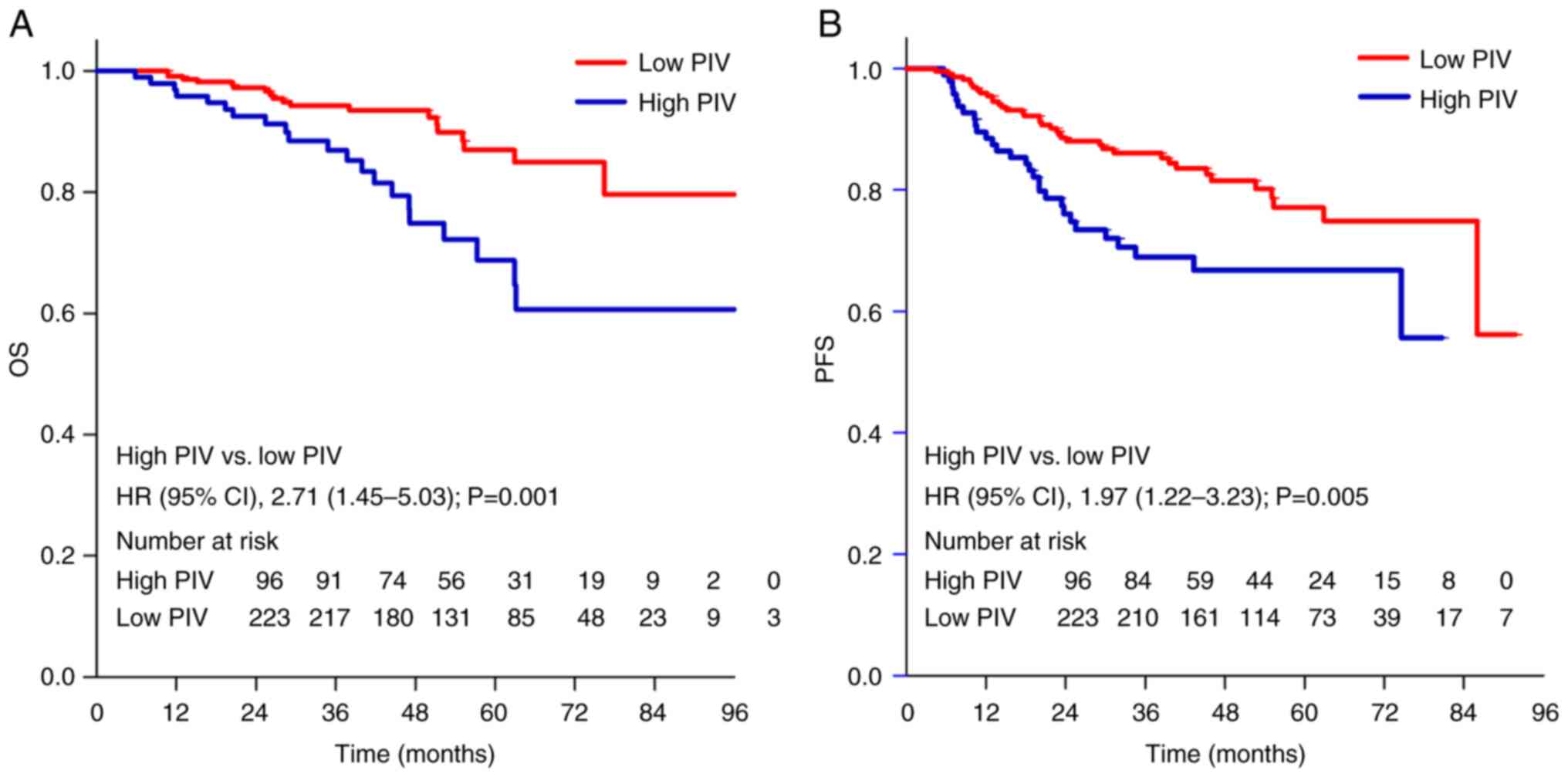|
1
|
Chen YP, Chan ATC, Le QT, Blanchard P, Sun
Y and Ma J: Nasopharyngeal carcinoma. Lancet. 394:64–80. 2019.
View Article : Google Scholar : PubMed/NCBI
|
|
2
|
Tang LL, Chen YP, Chen CB, Chen MY, Chen
NY, Chen XZ, Du XJ, Fang WF, Feng M, Gao J, et al: The Chinese
Society of Clinical Oncology (CSCO) clinical guidelines for the
diagnosis and treatment of nasopharyngeal carcinoma. Cancer Commun
(Lond). 41:1195–1227. 2021. View Article : Google Scholar : PubMed/NCBI
|
|
3
|
Özdemir F and Baskiran A: The importance
of AFP in liver transplantation for HCC. J Gastrointest Cancer.
51:1127–1132. 2020. View Article : Google Scholar : PubMed/NCBI
|
|
4
|
Zhang M, Cheng S, Jin Y, Zhao Y and Wang
Y: Roles of CA125 in diagnosis, prediction, and oncogenesis of
ovarian cancer. Biochim Biophys Acta Rev Cancer. 1875:1885032021.
View Article : Google Scholar : PubMed/NCBI
|
|
5
|
Au KH, Ngan RKC, Ng AWY, Poon DMC, Ng WT,
Yuen KT, Lee VHF, Tung SY, Chan ATC, Sze HCK, et al: Treatment
outcomes of nasopharyngeal carcinoma in modern era after intensity
modulated radiotherapy (IMRT) in Hong Kong: A report of 3328
patients (HKNPCSG 1301 study). Oral Oncol. 77:16–21. 2018.
View Article : Google Scholar : PubMed/NCBI
|
|
6
|
Su L, Zhang M, Zhang W, Cai C and Hong J:
Pretreatment hematologic markers as prognostic factors in patients
with nasopharyngeal carcinoma: A systematic review and
meta-analysis. Medicine (Baltimore). 96:e63642017. View Article : Google Scholar : PubMed/NCBI
|
|
7
|
Su Z, Mao YP, OuYang PY, Tang J and Xie
FY: Initial hyperleukocytosis and neutrophilia in nasopharyngeal
carcinoma: Incidence and prognostic impact. PLoS One.
10:e01367522015. View Article : Google Scholar : PubMed/NCBI
|
|
8
|
Jiang W, Chen Y, Huang J, Xi D, Chen J,
Shao Y, Xu G, Ying W, Wei J, Chen J, et al: Systemic
immune-inflammation index predicts the clinical outcome in patients
with nasopharyngeal carcinoma: A propensity score-matched analysis.
Oncotarget. 8:66075–66086. 2017. View Article : Google Scholar : PubMed/NCBI
|
|
9
|
Takenaka Y, Kitamura T, Oya R, Ashida N,
Shimizu K, Takemura K, Yamamoto Y and Uno A: Prognostic role of
neutrophil-lymphocyte ratio in nasopharyngeal carcinoma: A
meta-analysis. PLoS One. 12:e01814782017. View Article : Google Scholar : PubMed/NCBI
|
|
10
|
Li Q, Yu L, Yang P and Hu Q: Prognostic
value of inflammatory markers in nasopharyngeal carcinoma patients
in the intensity-modulated radiotherapy Era. Cancer Manag Res.
13:6799–6810. 2021. View Article : Google Scholar : PubMed/NCBI
|
|
11
|
Chen Y, Sun J, Hu D, Zhang J, Xu Y, Feng
H, Chen Z, Luo Y, Lou Y and Wu H: Predictive value of pretreatment
lymphocyte-to-monocyte ratio and platelet-to-lymphocyte ratio in
the survival of nasopharyngeal carcinoma patients. Cancer Manag
Res. 13:8767–8779. 2021. View Article : Google Scholar : PubMed/NCBI
|
|
12
|
Xiong Y, Shi LL, Zhu LS, Ding Q, Ba L and
Peng G: Prognostic efficacy of the combination of the pretreatment
systemic immune-inflammation index and epstein-barr virus DNA
status in locally advanced nasopharyngeal carcinoma patients. J
Cancer. 12:2275–2284. 2021. View Article : Google Scholar : PubMed/NCBI
|
|
13
|
Zeng X, Liu G, Pan Y and Li Y: Development
and validation of immune inflammation-based index for predicting
the clinical outcome in patients with nasopharyngeal carcinoma. J
Cell Mol Med. 24:8326–8349. 2020. View Article : Google Scholar : PubMed/NCBI
|
|
14
|
Yang S, Zhao K, Ding X, Jiang H and Lu H:
Prognostic significance of hematological markers for patients with
nasopharyngeal carcinoma: A meta-analysis. J Cancer. 10:2568–2577.
2019. View Article : Google Scholar : PubMed/NCBI
|
|
15
|
Yang P, Zhao Y, Liang H, Zhou G, Youssef
B, Elhalawani H, Li M, Tan F, Jin Y, Jin H, et al:
Neutrophil-to-lymphocyte ratio trend: A novel prognostic predictor
in patients with nasopharyngeal carcinoma receiving radiotherapy.
Int J Biol Markers. 37:270–279. 2022. View Article : Google Scholar : PubMed/NCBI
|
|
16
|
Oei RW, Ye L, Kong F, Du C, Zhai R, Xu T,
Shen C, Wang X, He X, Kong L, et al: Prognostic value of
inflammation-based prognostic index in patients with nasopharyngeal
carcinoma: A propensity score matching study. Cancer Manag Res.
10:2785–2797. 2018. View Article : Google Scholar : PubMed/NCBI
|
|
17
|
Lin C, Lin S, Guo QJ, Zong JF, Lu TZ, Lin
N, Lin SJ and Pan JJ: Systemic immune-inflammation index as a
prognostic marker in patients with newly diagnosed metastatic
nasopharyngeal carcinoma: A propensity score-matched study. Transl
Cancer Res. 8:2089–2098. 2019. View Article : Google Scholar : PubMed/NCBI
|
|
18
|
Lin F, Zhang LP, Xie SY, Huang HY, Chen
XY, Jiang TC, Guo L and Lin HX: Pan-Immune-Inflammation Value: A
new prognostic index in operative breast cancer. Front Oncol.
12:8301382022. View Article : Google Scholar : PubMed/NCBI
|
|
19
|
Sato S, Shimizu T, Ishizuka M, Suda K,
Shibuya N, Hachiya H, Iso Y, Takagi K, Aoki T and Kubota K: The
preoperative pan-immune-inflammation value is a novel prognostic
predictor for with stage I–III colorectal cancer patients
undergoing surgery. Surg Today. 52:1160–1169. 2022. View Article : Google Scholar : PubMed/NCBI
|
|
20
|
Sahin AB, Cubukcu E, Ocak B, Deligonul A,
Oyucu Orhan S, Tolunay S, Gokgoz MS, Cetintas S, Yarbas G, Senol K,
et al: Low pan-immune-inflammation-value predicts better
chemotherapy response and survival in breast cancer patients
treated with neoadjuvant chemotherapy. Sci Rep. 11:146622021.
View Article : Google Scholar : PubMed/NCBI
|
|
21
|
Guven DC, Yildirim HC, Bilgin E, Aktepe
OH, Taban H, Sahin TK, Cakir IY, Akin S, Dizdar O, Aksoy S, et al:
PILE: A candidate prognostic score in cancer patients treated with
immunotherapy. Clin Transl Oncol. 23:1630–1636. 2021. View Article : Google Scholar : PubMed/NCBI
|
|
22
|
Fuca G, Beninato T, Bini M, Mazzeo L, Di
Guardo L, Cimminiello C, Randon G, Apollonio G, Bisogno I, Del
Vecchio M, et al: The pan-immune-inflammation value in patients
with metastatic melanoma receiving first-line therapy. Target
Oncol. 16:529–536. 2021. View Article : Google Scholar : PubMed/NCBI
|
|
23
|
Ligorio F, Fuca G, Zattarin E, Lobefaro R,
Zambelli L, Leporati R, Rea C, Mariani G, Bianchi GV, Capri G, et
al: The pan-immune-inflammation-value predicts the survival of
patients with human epidermal growth factor receptor 2
(HER2)-Positive advanced breast cancer treated with first-line
taxane-trastuzumab-pertuzumab. Cancers (Basel). 13:19642021.
View Article : Google Scholar : PubMed/NCBI
|
|
24
|
Fuca G, Guarini V, Antoniotti C, Morano F,
Moretto R, Corallo S, Marmorino F, Lonardi S, Rimassa L,
Sartore-Bianchi A, et al: The Pan-Immune-Inflammation Value is a
new prognostic biomarker in metastatic colorectal cancer: Results
from a pooled-analysis of the Valentino and TRIBE first-line
trials. Br J Cancer. 123:403–409. 2020. View Article : Google Scholar : PubMed/NCBI
|
|
25
|
Baba Y, Nakagawa S, Toihata T, Harada K,
Iwatsuki M, Hayashi H, Miyamoto Y, Yoshida N and Baba H:
Pan-immune-inflammation value and prognosis in patients with
esophageal cancer. Ann Surg Open. 3:e1132021. View Article : Google Scholar : PubMed/NCBI
|
|
26
|
Guven DC, Sahin TK, Erul E, Kilickap S,
Gambichler T and Aksoy S: The association between the
pan-immune-inflammation value and cancer prognosis: A systematic
review and meta-analysis. Cancers (Basel). 14:26752022. View Article : Google Scholar : PubMed/NCBI
|
|
27
|
Yang XC, Liu H, Liu DC, Tong C, Liang XW
and Chen RH: Prognostic value of pan-immune-inflammation value in
colorectal cancer patients: A systematic review and meta-analysis.
Front Oncol. 12:10368902022. View Article : Google Scholar : PubMed/NCBI
|
|
28
|
Amin MB, Greene FL, Byrd DR, Brookland RK,
Washington MK, Gershenwald JE, Compton CC, Hess KR, Sullivan DC,
Jessup JM, et al: AJCC Cancer Staging Manual. 8th edition.
Springer; New York, NY: 2017
|
|
29
|
Pfister DC, Spencer S, Adelstein D, Adkins
D, Anzai Y, Brizel DM, Bruce JY, Busse PM, Caudell JJ, Cmelak AJ,
et al: Head and neck cancers, version 2.2020, NCCN clinical
practice guidelines in oncology. J Natl Compr Canc Netw.
18:873–898. 2020. View Article : Google Scholar : PubMed/NCBI
|
|
30
|
Yates JW, Chalmer B and McKegney FP:
Evaluation of patients with advanced cancer using the Karnofsky
performance status. Cancer. 45:2220–2224. 1980. View Article : Google Scholar : PubMed/NCBI
|
|
31
|
Khandia R and Munjal A: Interplay between
inflammation and cancer. Adv Protein Chem Struct Biol. 119:199–245.
2020. View Article : Google Scholar : PubMed/NCBI
|
|
32
|
Singh N, Baby D, Rajguru JP, Patil PB,
Thakkannavar SS and Pujari VB: Inflammation and cancer. Ann Afr
Med. 18:121–126. 2019. View Article : Google Scholar : PubMed/NCBI
|
|
33
|
Murata M: Inflammation and cancer. Environ
Health Prev Med. 23:502018. View Article : Google Scholar : PubMed/NCBI
|
|
34
|
Dupre A and Malik HZ: Inflammation and
cancer: What a surgical oncologist should know. Eur J Surg Oncol.
44:566–570. 2018. View Article : Google Scholar : PubMed/NCBI
|
|
35
|
Wu L, Saxena S, Awaji M and Singh RK:
Tumor-Associated neutrophils in cancer: Going Pro. Cancers (Basel).
11:5642019. View Article : Google Scholar : PubMed/NCBI
|
|
36
|
Shibutani M, Maeda K, Nagahara H, Fukuoka
T, Nakao S, Matsutani S, Hirakawa K and Ohira M: The peripheral
monocyte count is associated with the density of tumor-associated
macrophages in the tumor microenvironment of colorectal cancer: A
retrospective study. BMC Cancer. 17:4042017. View Article : Google Scholar : PubMed/NCBI
|
|
37
|
Shigeta K, Kosaka T, Kitano S, Yasumizu Y,
Miyazaki Y, Mizuno R, Shinojima T, Kikuchi E, Miyajima A, Tanoguchi
H, et al: High absolute monocyte count predicts poor clinical
outcome in patients with castration-resistant prostate cancer
treated with docetaxel chemotherapy. Ann Surg Oncol. 23:4115–4122.
2016. View Article : Google Scholar : PubMed/NCBI
|
|
38
|
Zhou J, Tang Z, Gao S, Li C, Feng Y and
Zhou X: Tumor-Associated macrophages: Recent insights and
therapies. Front Oncol. 10:1882020. View Article : Google Scholar : PubMed/NCBI
|
|
39
|
Chen Y, Song Y, Du W, Gong L, Chang H and
Zou Z: Tumor-associated macrophages: An accomplice in solid tumor
progression. J Biomed Sci. 26:782019. View Article : Google Scholar : PubMed/NCBI
|
|
40
|
Sharma D, Brummel-Ziedins KE, Bouchard BA
and Holmes CE: Platelets in tumor progression: A host factor that
offers multiple potential targets in the treatment of cancer. J
Cell Physiol. 229:1005–1015. 2014. View Article : Google Scholar : PubMed/NCBI
|
|
41
|
Schmied L, Hoglund P and Meinke S:
Platelet-Mediated protection of cancer cells from immune
surveillance-possible implications for cancer immunotherapy. Front
Immunol. 12:6405782021. View Article : Google Scholar : PubMed/NCBI
|
|
42
|
Giannakeas V, Kotsopoulos J, Brooks JD,
Cheung MC, Rosella L, Lipscombe L, Akbari MR, Austin PC and Narod
SA: Platelet count and survival after cancer. Cancers (Basel).
14:5492022. View Article : Google Scholar : PubMed/NCBI
|
|
43
|
Quigley DA and Kristensen V: Predicting
prognosis and therapeutic response from interactions between
lymphocytes and tumor cells. Mol Oncol. 9:2054–2062. 2015.
View Article : Google Scholar : PubMed/NCBI
|
|
44
|
Feng Y, Zhang N, Wang S, Zou W, He Y, Ma
JA, Liu P, Liu X, Hu C and Hou T: Systemic inflammation response
index is a predictor of poor survival in locally advanced
nasopharyngeal carcinoma: A propensity score matching study. Front
Oncol. 10:5754172020. View Article : Google Scholar : PubMed/NCBI
|
|
45
|
Chen Y, Jiang W, Xi D, Chen J, Xu G, Yin
W, Chen J and Gu W: Development and validation of nomogram based on
SIRI for predicting the clinical outcome in patients with
nasopharyngeal carcinomas. J Investig Med. 67:691–698. 2019.
View Article : Google Scholar : PubMed/NCBI
|
|
46
|
Demir H, Demirci A, Eren SK, Beypinar I,
Davarcı SE and Baykara M: A new prognostic index in young breast
cancer patients. J Coll Physicians Surg Pak. 32:86–91. 2022.
View Article : Google Scholar : PubMed/NCBI
|
|
47
|
Kim KY, Le QT, Yom SS, Pinsky BA, Bratman
SV, Ng RH, El Mubarak HS, Chan KC, Sander M and Conley BA: Current
state of PCR-Based epstein-barr virus DNA testing for
nasopharyngeal cancer. J Natl Cancer Inst. 109:djx0072017.
View Article : Google Scholar : PubMed/NCBI
|
|
48
|
Le QT, Zhang Q, Cao H, Cheng AJ, Pinsky
BA, Hong RL, Chang JT, Wang CW, Tsao KC, Lo YD, et al: An
international collaboration to harmonize the quantitative plasma
Epstein-Barr virus DNA assay for future biomarker-guided trials in
nasopharyngeal carcinoma. Clin Cancer Res. 19:2208–2215. 2013.
View Article : Google Scholar : PubMed/NCBI
|

















